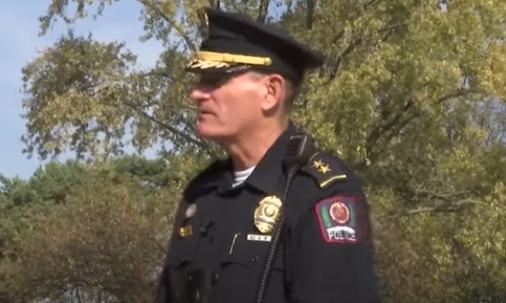Ohio State University students are calling for better safety alerts from the university after a senior, Collin Clark, was robbed at gunpoint close to campus. Clark’s encounter happened just off campus in a neighborhood largely populated by Ohio State students, sparking concerns that crime near campus is not being properly communicated to the student body. Although Ohio State issues “Buckeye Alerts” for on-campus incidents, Clark’s experience has brought to light gaps in the university’s alert system, leaving students uneasy and demanding improved safety measures.

Terrifying Encounter Near Campus
Clark, an Ohio State senior, was walking home from a friend’s house just after midnight when he found himself in a frightening situation. As he approached an alley near campus, he noticed a car parked, partially blocking the sidewalk. Suddenly, a man appeared from the passenger side of the car, pointed a gun at Clark, and demanded he hand over everything in his pockets, threatening to shoot if he didn’t comply. The location, though technically off campus, is only a minute’s walk from the university’s boundaries and is a common route for students heading to and from campus.
This encounter left Clark shaken, particularly because he frequently walks through the area without ever expecting an incident like this to occur. “I never even thought I would have an issue, especially so close to High Street,” Clark said, referring to the popular street that runs through the heart of Ohio State’s campus. Clark’s phone and other belongings were stolen, and after the robbery, he borrowed a friend’s phone to call the police.
Ohio State’s Alert System Under Scrutiny
Following the robbery, Clark contacted the Columbus Police Department (CPD), which responded to the scene quickly. While sitting in a police car, Clark learned that a similar robbery had reportedly taken place nearby, adding to his concern that students may be at risk of encountering similar threats around campus. However, he soon realized that Ohio State had not issued any public safety alerts to warn students of these incidents.
Ohio State’s current policy dictates that Buckeye Alerts and public safety notices are issued primarily for incidents occurring on campus. According to an OSU spokesperson, off-campus crime reports are instead made available on the Community Crime Map, a resource that is less immediate and requires proactive checking. Ohio State University Police and Columbus Police collaborate on campus safety, but the university typically doesn’t issue alerts for incidents that occur off campus. This policy has raised questions among students, particularly as Clark’s experience is not isolated; he is one of many students living in areas immediately adjacent to campus, where they often walk unaccompanied at night.
While the university’s policy does allow for off-campus alerts in specific cases, such as when public safety officials deem an incident to be particularly concerning or relevant to students, a review of the last five years’ safety notices shows that only 10 alerts have been issued for off-campus incidents. Students like Clark are increasingly calling for Ohio State to change its alert criteria, particularly given the significant number of students living in neighborhoods just beyond the official boundaries of campus.
University’s Approach to Off-Campus Crime
The issue of off-campus crime has been a longstanding concern for Ohio State University’s police department, and the new Chief of Police, Dennis Jeffrey, addressed this issue directly just two weeks prior. He acknowledged that the most significant safety challenges Ohio State faces occur in areas adjacent to campus, specifically on High Street and nearby neighborhoods where students often reside and socialize.
Chief Jeffrey emphasized the need for heightened vigilance in these areas but has yet to specify any changes to the university’s alert system. For students like Clark, this acknowledgment is not enough. Clark feels that the university could make a greater effort to inform students when serious crimes happen within close proximity to campus. “I really would like to see better emphasis on this kind of situation—this was right near campus, this was armed robbery,” Clark noted, highlighting the need for a timely alert system that recognizes incidents close to campus.
Ohio State Police’s Response and Student Reactions
Clark’s experience has intensified the sense of unease among Ohio State’s student body. While students understand that the university cannot prevent all off-campus crime, they are pressing for a more responsive and proactive alert system. Students point out that the existing community crime map isn’t widely used and does not provide real-time updates, creating a gap in students’ awareness of immediate safety concerns.
In response, students like Clark and others affected by off-campus crime are asking the university to consider expanding its alert criteria to include incidents that, while technically off campus, still pose a real and immediate threat to the student population. Additionally, Clark’s story highlights a broader issue at universities across the country, where off-campus crime remains a significant yet challenging aspect of campus safety.
Ohio State’s reluctance to issue Buckeye Alerts for off-campus incidents stems from a desire to keep students informed without causing undue alarm, yet Clark’s case demonstrates how a lack of information can create an equally unsafe environment. For now, Clark and other students are left to rely on word of mouth and the community crime map, both of which fail to deliver the immediate awareness many feel is necessary.
Looking Forward: Enhancing Campus Safety Measures
Ohio State University’s response to Clark’s call for improved safety alerts remains to be seen. The university’s administration and police force face a difficult balance in maintaining transparency, ensuring safety, and managing student expectations. However, Clark’s experience underscores the need for an evolving approach that takes into account the growing student population residing off campus.
As more students speak out about their concerns, Ohio State may need to re-evaluate its current alert system and consider a model that better reflects the realities of campus life today. For now, students like Clark are left with increased vigilance and a call to their university to make off-campus safety as much a priority as on-campus incidents.

















